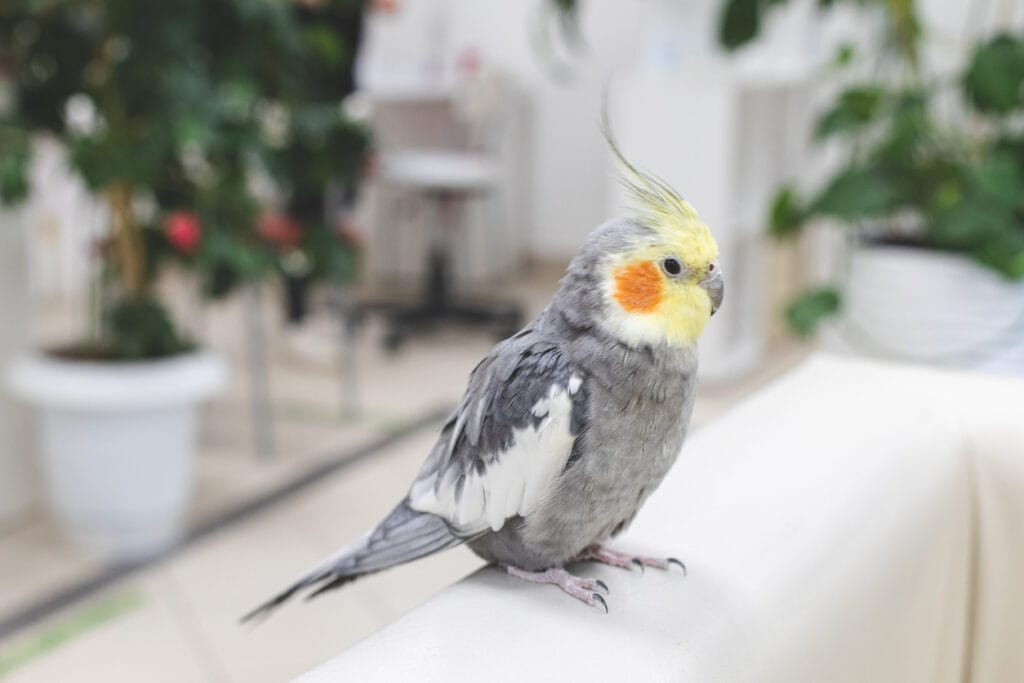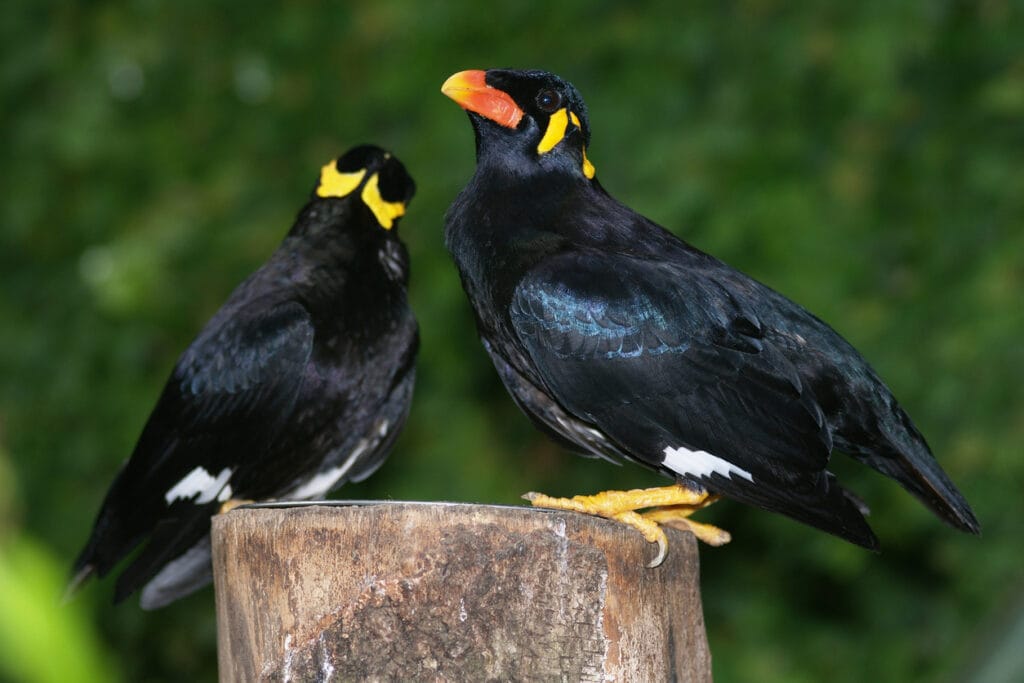Regardless of species, no bird will learn to talk unless it spends ample time interacting with its caretaker and practicing words. And even with practice, some birds might never master mimicking the human voice. But what are the most popular cheap talking birds to keep as a pet?
Here is a list of the top eight cheap talking birds:
- Budgerigar
- Indian Ringneck Parakeet
- Quaker Parrot
- Senegal Parrot
- Blue-crowned Conure
- Black-Hooded Parakeet
- Cockatiels
- Parrotlets
Keep reading to learn more about the best cheap talking birds and why we picked them!
1. Budgerigar

The Budgerigar is among the most popular and smallest pets and is one of the best talking birds.
Capable of learning hundreds of words, far more than many birds several times its size, the Budgies (also known as Parakeets) is one of the smallest and most popular pet birds.
Author Note: Patient and consistent owners are often rewarded with birds that constantly chatter using words, but it can take some practice to get these small parrots to start talking.
Fully grown, the Budgerigar will reach a length of six to eight inches with a body mass of One ounce.
The Budgerigar has a yellow head, dark blue tail, a green abdomen, and a black and yellow back, and mutations include grey, white and yellow.
2. Indian Ringneck Parakeet

Once only available as pets to those in a position of nobility, the Indian parakeet can boast a vocabulary of more than five hundred words.
With some Indian ringneck parakeets boasting vocabularies of more than 500 words, it’s no wonder these birds once were only available as pets to those in positions of nobility.
At one point, religious leaders in India observed the birds reciting poems in the prayer garden, and they were thought to be holy. Subsequently, they realized that the birds were simply mimicking the people’s daily prayer sessions.
Fully grown, the Indian Ringneck parakeet can reach a length of between fourteen to seventeen inches with a body mass of four ounces.
The Indian ringneck parakeet has yellow under its wings, a blue tail green plumage. Males have black and pinkish/red rings around their necks, and mutations include lutino, albino, blue, and cinnamon.
3. Quaker Parrot

The Quaker Parrot (also known as the Monk parakeet) is known to be chatterboxes, with high-quality speech and a spunky personality. Quaker parrots are considered to be potentially invasive to wildlife if they escape, and in some parts of the United States, it is illegal to keep them as pets.
Should you be interested in a quaker as a pet, please check the local laws and check with local authorities.
Fully grown, the Quaker parrot can reach a length of between eleven to twelve inches and with a body mass of three to five ounces,
Author Note: The quaker parrot has a green head, wings, body, grey breasts, throat, and cheeks with blue flight feathers.
Mutations include albino, blue, lutino, pied, and cinnamon.
4. Senegal Parrot

An extremely charming bird that thrives on socialization with its owner/caretaker, the Senegal parrot is native to Africa. You should dedicate several hours each day to interact with your bird if you’re considering this species.
These birds do have the ability to mimic speech (with regular training) and tend to be somewhat calmer and quieter than other parrot species.
Fully grown, the Senegal parrot can reach a length of ten inches and a body mass of four to five ounces.
The Senegal parrot has a v-shaped red to yellow on its belly, green chest, and wings with a grey head.
5. Blue-Crowned Conure

The Blue-crowned conure is another great option for a medium-sized talking bird. Not known as the best talkers, they do have the ability to mimic other sounds like cellphone ringtones or the beeping of an alarm clock.
With frequent training sessions, the Blue-crowned conure is capable of learning several words and sentences but has the capacity to shriek extremely loudly, so it’s not ideal for apartment living.
Fully grown, the blue-crowned conure can reach a length of fifteen inches with a body mass of between three to six inches.
The blue-crowned conure has a bright blue head, white rings around its eyes, pink legs, a reddish tail tip, and a body.
6. The Black-Hooded Parakeet

The black-hooded parakeet (or nanday conure) is an extremely intelligent medium-sized bird that enjoys socializing and play. They love learning new tricks and are known to be quite affectionate with their caretakers.
Although their voices are usually raspy and lack clarity, they are a vocal species with the ability to learn some words and short phrases.
Author Note: Fully grown the black-hooded parakeet can reach a length of between ten and eleven inches with a body mass of five ounces.
The black-hooded parakeet has a black head, white eye-rings, black beak, greyish-blue chest patch, blue tail with red accent on their legs.
7. Cockatiels

Cockatiels can be taught a few words but aren’t as chatty as other pet bird species. However, they have the ability to mimic household noises such as alarm clocks, telephone ringers, doorbells, and microwaves. Some cockatiels are able to whistle entire songs and are known to be extremely accomplished whistlers.
Fully grown the cockatiel can reach a length of twelve to thirteen inches with a body mass of three ounces.
Cockatiels have a yellow face and crest, long tail with a grey body. Mutations include cinnamon, lutino, and albino.
8. Parrotlets

Parrotlets have massive personalities packed into tiny bodies. Although some can learn to speak a few words in a much quieter volume than larger parrots, they are not particularly recognized for their talking ability.
These “pocket parrots” are intelligent, active little birds that can be very sweet companions when properly socialized.
The parrotlet can reach a length of four to five inches with a body mass of one ounce.
Parrotlets have a green body and head, blue on the back and behind eyes; mutations include white, blue, and yellow.
Which Should I Choose?
Not all talk is cheap- which is what many people discover when they begin looking for an interesting bird to keep as a pet. Talking birds are often the bird of choice for many people looking to keep a bird as a pet.
What they often don’t realize is that talking birds can be expensive. But, don’t lose hope just yet- there are ways to get cheap talking birds to keep as a pet. They just might not be the way you initially think.
But we will touch more on that subject in a little bit.
Finding Your New Pet Talking Bird
When some people think of a talking pet bird, they might picture a large Amazon parrot or Eclectus. But there are many small- to medium-sized bird species that can learn to talk just as well as their larger parrot cousins. Some species have the capacity to learn a plethora of words and phrases, while others only tend to repeat a few simple words.
Before you go out and commit to getting a bird as a pet, especially a talking bird, there are a couple of things you should remember. Firstly, a bird is not an ornament. Getting a cheap talking bird for your home or as a family pet should be treated as a serious thing- not just a gift that you will forget about.
Birds are living creatures, and they should be seen as part of your family. This goes for any pet that you introduce into your home. A talking bird, although it can be fun to teach them phrases and words, is not a novelty.
Most parrots can live long lives, and they often attach themselves to a particular family member. This can often be seen in the case of an African Grey parrot. But, an African Grey parrot is not necessarily a cheap bird to acquire. What’s more, many different types of parrots are on the endangered species list.
Endangered Species

Well, although there are many factors that contribute, poaching is one of the main culprits. So, if you are in the market for a talking bird, or any bird or animal for that matter, make sure that you know where the bird was sourced.
Always make the ethical choice, and if you suspect that the birds have been poached, then do not support the poachers by providing them with finances for the bird. Instead, reach out to your local authorities or contact the nearest animal welfare organization.
Author Note: Not only will they know what to do with the bird, but they will have the appropriate ways of handling the situation and the suspected poachers.
Now let’s circle back to the point we made earlier; talking birds are generally not cheap. However, there are ways you can not only acquire a talking bird for less than the premium market price, but you can do a good deed while you are at it.
There are many wonderful people in this world working to make it a better place. However, there are also many people that are not- and cause damage to other living creatures, such as the parrot and other talking birds, in their hunt for money.
How You Can Help

What happens when these poachers get caught? Or what happens when a bird gets injured, especially when it escapes from captivity and gets lost in a foreign environment? Sometimes, organizations are able to recapture the birds, but the birds are often too injured to go back into the wild.
They also might be too far from their natural habitat. In cases such as these, the birds will generally be held in a sanctuary of some sort.
Some sanctuaries do allow for rehoming, especially if the birds are too injured to be let out into the wild. This is where you should go seek your talking bird. Find a bird like this that needs a loving, good home, and you might just save yourself some money in the process.
This is, by far, the best way to get a cheap talking bird.
Conclusion
We hope you enjoyed this article on which cheap talking birds are the best! If you have your own favorite type of cheap talking bird, let us know about it in the comments below.
Fly high friends!











Thanks a lot. That’s the answer that I care. I have a plan to buy a talk parrot. So learning about it is necessary. Hope you write more.
But I wonder that how long do talking parrots live?